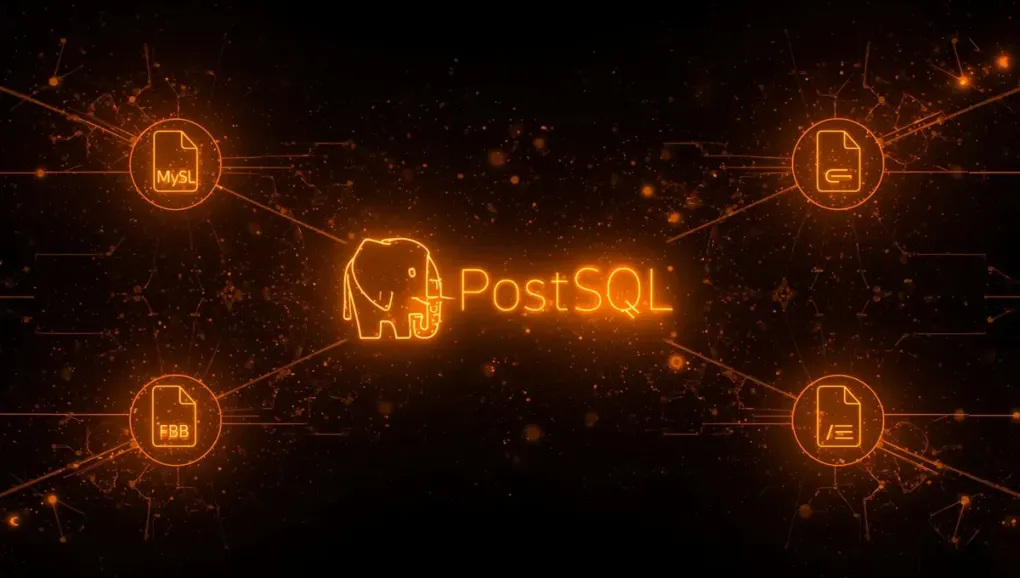
Postgres's Secret Weapon: The Magic of Foreign Data Wrappers
In the world of data, we often live in silos. Your main application data is in a PostgreSQL database, but customer information lives in a Salesforce CRM, logs are streamed to an Elasticsearch cluster, and maybe you have some legacy data sitting in a MySQL database or even a collection of CSV files. Querying across these boundaries is usually a nightmare, involving custom scripts, brittle ETL jobs, and a lot of manual data wrangling.
But what if it didn’t have to be this way? What if you could query all of these disparate data sources directly from your familiar PostgreSQL instance, using standard SQL? This isn’t a fantasy; it’s a built-in feature of PostgreSQL called Foreign Data Wrappers (FDWs), and it’s one of the most powerful, underutilized tools in the entire database ecosystem.
What Are Foreign Data Wrappers?
A Foreign Data Wrapper is essentially a driver or a plugin that teaches PostgreSQL how to communicate with an external data source. It acts as a translation layer, mapping the external data structure into a format that looks and feels just like a regular PostgreSQL table.
Once an FDW is configured, you can perform SELECT queries (and in many cases, INSERT, UPDATE, and DELETE operations) on the “foreign table” as if it were physically stored inside your PostgreSQL database. The FDW handles all the complexity of connecting to the remote source, translating your SQL query into the appropriate API call or remote query language, and returning the data in a format Postgres understands.
Think of it as a universal adapter for data. You have a PostgreSQL-shaped plug, and you need to connect it to a MySQL-shaped socket, a CSV-shaped socket, or even a Twitter-API-shaped socket. The FDW is the adapter that makes it all fit together seamlessly.
The “Database of Databases” in Action
Let’s imagine a practical scenario. You run an e-commerce platform. Your product and sales data are in your primary PostgreSQL database. However, your real-time inventory data is managed by a separate microservice with a MySQL database, and your customer support tickets are stored in a Zendesk-like service accessible via a REST API.
A customer calls to ask about the status of their recent order and whether the product they want is in stock.
The Old Way:
- A support agent queries the PostgreSQL database to find the customer’s order history.
- The agent then has to switch to a separate inventory management system to check stock levels for a product.
- Finally, they might have to look up the customer’s recent support tickets in yet another system.
The FDW Way:
You configure mysql_fdw to connect to the inventory database and a custom api_fdw to connect to the support ticket API. Now, you can create a single, unified view for your support team:
CREATE VIEW support_dashboard AS
SELECT
c.customer_name,
o.order_date,
o.status,
i.stock_level,
t.last_ticket_subject
FROM
orders AS o
JOIN
inventory_foreign_table AS i ON o.product_id = i.product_id
LEFT JOIN
tickets_foreign_table AS t ON o.customer_id = t.customer_id
WHERE
c.customer_id = 12345;With one simple SQL query, you’ve joined data across three completely different systems. Your application logic remains clean, and you’ve leveraged the power of the PostgreSQL query planner to orchestrate the data retrieval. This is a game-changer for building unified views, generating reports, and simplifying application development.
A Universe of Wrappers
The beauty of the FDW system is its extensibility. The community has built wrappers for an astonishing variety of data sources:
- Other SQL Databases:
mysql_fdw,oracle_fdw,mssql_fdw - NoSQL Databases:
mongo_fdw,redis_fdw,cassandra_fdw - Files:
file_fdwfor reading CSVs or other flat files directly from the server. - Big Data Systems:
hdfs_fdwfor Hadoop,clickhouse_fdw - APIs: Generic wrappers like
http_fdwor specific ones liketwitter_fdworstripe_fdw.
The Fine Print: Performance and Limitations
While FDWs are incredibly powerful, they aren’t magic. The performance of a query on a foreign table is highly dependent on the FDW’s implementation and the capabilities of the remote data source. A well-designed FDW can perform “predicate pushdown,” where it translates your WHERE clauses into a filter on the remote end, so you only pull the data you need. A simpler FDW might have to pull the entire remote dataset into memory before filtering, which can be slow and resource-intensive.
It’s crucial to understand the capabilities of the specific FDW you’re using and to test your queries accordingly.
Conclusion: Your Database is More Powerful Than You Think
Foreign Data Wrappers transform PostgreSQL from a simple database into a powerful data federation hub. They break down data silos, simplify complex architectures, and allow you to leverage the power of SQL across your entire data landscape. It’s a feature that embodies the PostgreSQL philosophy: robust, extensible, and built to solve real-world problems. The next time you find yourself writing a script to shuffle data between systems, take a moment to ask: “Is there an FDW for that?” The answer might surprise you.


